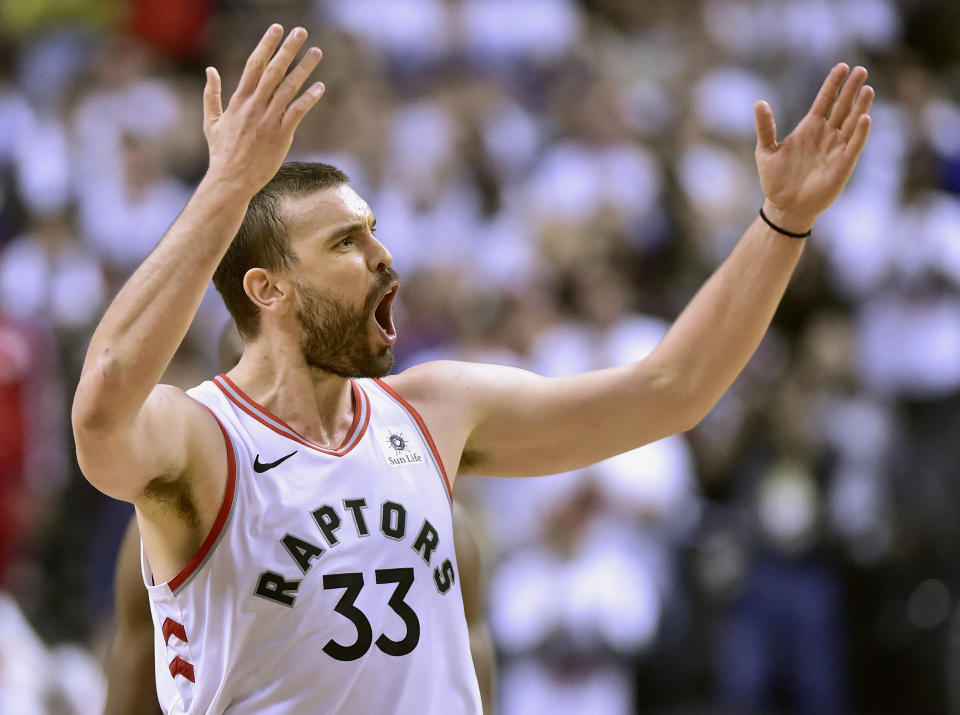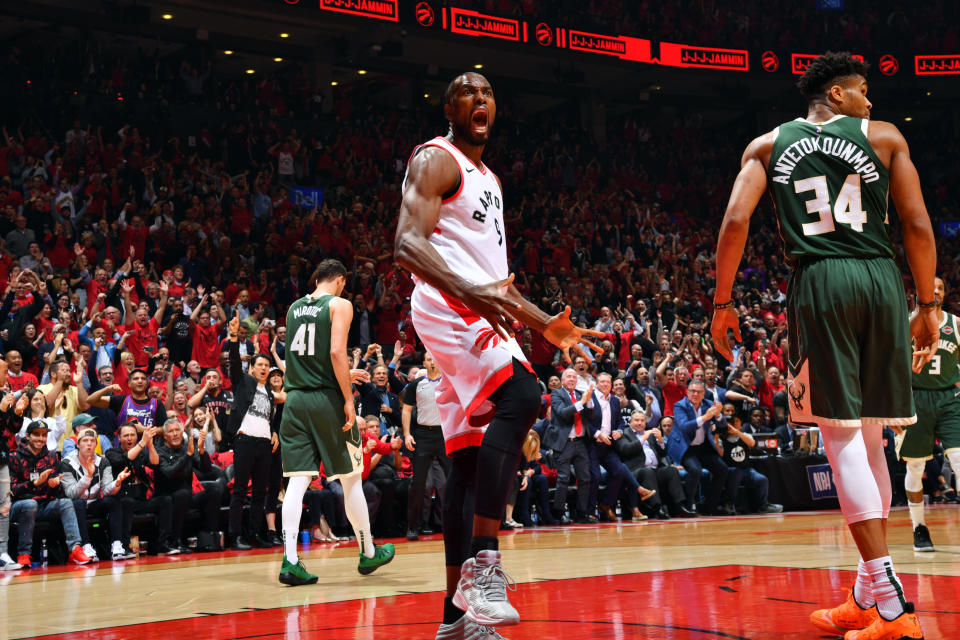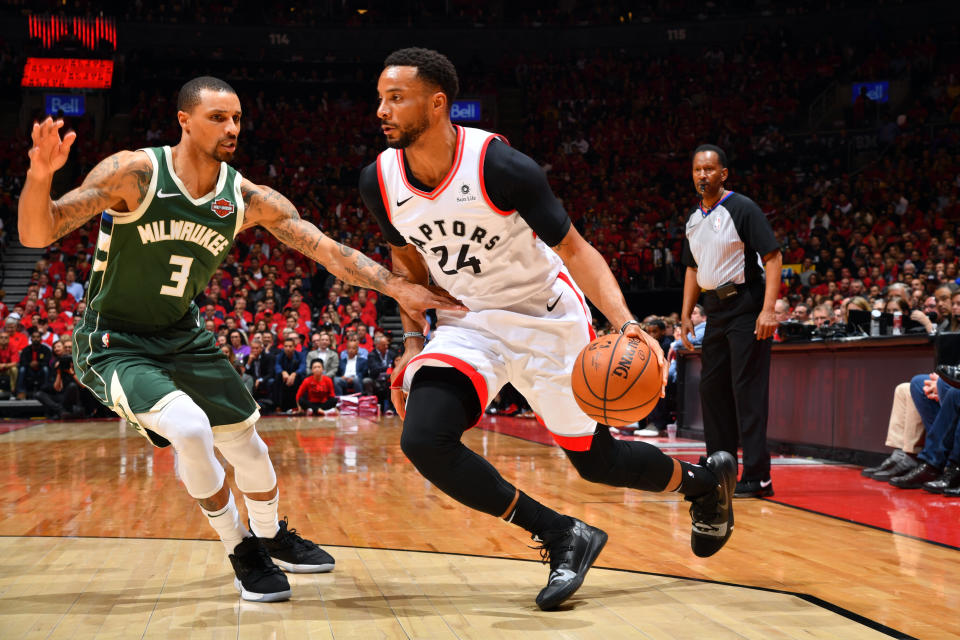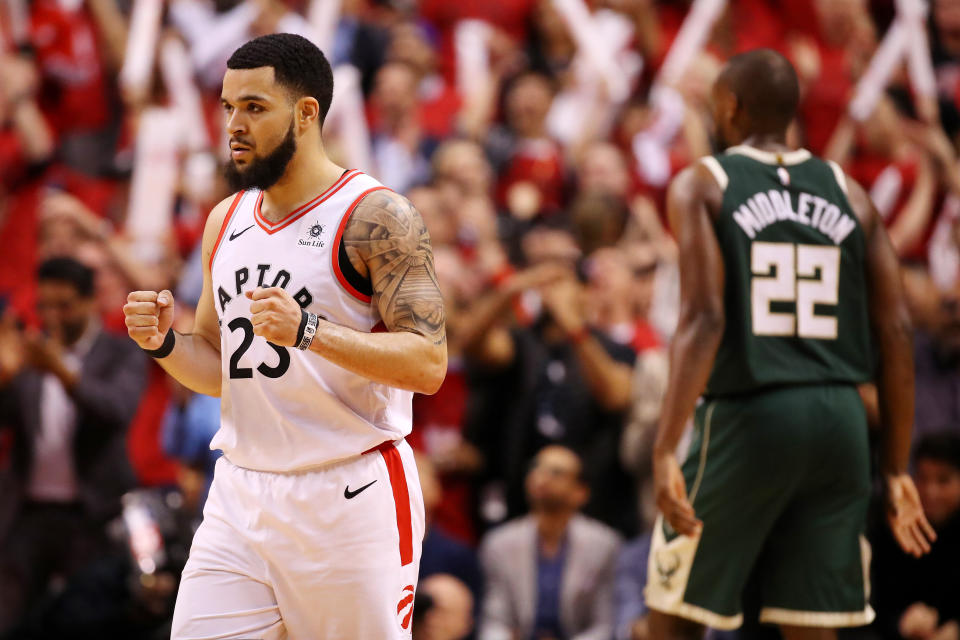Raptors' role players can look to Game 4 as blueprint for beating Bucks
TORONTO — The one definitive advantage favoring the Milwaukee Bucks in the Eastern Conference Finals against the Toronto Raptors was that the Bucks had a more reliable set of role players surrounding their superstar.
So effective was Milwaukee’s bench that Giannis Antetokounmpo’s minutes had actually dropped from the regular season to the playoffs. The likes of George Hill and Pat Connaughton were so productive against the Boston Celtics that leads were established and extended even when the presumptive Most Valuable Player sat on the bench. This was done even without Malcolm Brogdon, a defensively-robust 50-40-90 starter who was sidelined for all but one game with plantar fasciitis.
Contrast that to Toronto, who strung it out at times on a tight six-man rotation and a throwback frontcourt featuring three bigs sharing non-existent spacing just to squeak past the Philadelphia 76ers by the narrowest of margins. Out of necessity, Kawhi Leonard poured every ounce of himself into putting on a convincing Michael Jordan impersonation, and the Raptors needed every one of his 243 points, two game-winners, and four fateful bounces over seven games just to survive.
Just in terms of sheer attrition, the Bucks looked to have the Raptors beat, and it proved true over the first three games. Milwaukee’s reserves nearly doubled their counterparts 130-78 in bench points, and had the Raptors on the ropes for an 0-3 deficit that would have surely broken their spirit. Leonard willed the Raptors across the finish line, but he also limped for four quarters and two overtimes, and it looked as if Toronto had exhausted itself just for one result.
However, the narrative flipped in Game 4, where it was Toronto’s second unit that won 48-23 as part of a team-wide effort to pick up for Leonard. With the result came a surge of confidence for the Raptors, as they suddenly had momentum against an inexperienced Bucks team that felt, for the first time all season, their first moment of vulnerability. And it was that team effort that inspired the most confidence, because the Raptors always had the better starting five. If the second unit could even come close to holding even, they would suddenly become the favorites in a series that had looked decidedly in the Bucks’ favor.
Granted, supporting pieces generally tend to perform better at home, and the Raptors can’t expect to keep persisting off the Bucks’ errors. However, that performance in Game 4 did present a blueprint for Marc Gasol, Serge Ibaka, Norman Powell, and Fred VanVleet to be successful for the rest of the series.
Marc Gasol: Shoot first, then make plays

Gasol’s role is to wall off the paint against Giannis Antetokounmpo on defense, while opening up the paint and creating for others on offense. The first part was never really in doubt for the former Defensive Player of the Year, but Gasol opened as a net negative on offense as he hit 3-of-20 from the field in Games 1 and 2.
The 7-foot Spaniard was much better at home in Toronto, where he posted 33 points with seven made threes, along with 14 assists in 76 minutes. The pattern in both games was the same: Gasol hit two triples in the first quarter, which forced the defense to respect his range, and that opened up the rest of his game.
It’s imperative for the Raptors to establish Gasol as a scoring threat, but more importantly, it’s on Gasol to embrace that responsibility. He can still make plays for others, but the scoring must come before the passing. Gasol is far more effective when he’s attacking the closeout, because he’s skilled enough to dribble past and either kick out to the corner shooter or find the cutter along the baseline. And even if Brook Lopez is stationary, simply drawing him out of the paint also creates space inside for Gasol to pick out cutters off split screen actions away from the ball.
Gasol also imposed himself on the Bucks when guarded by smaller players in the post. Again, the aggressive mindset was key, because for one reason or another Gasol just didn’t force the issue against the likes of Tobias Harris and Aaron Gordon in previous rounds. However, the Bucks are trying to get away with the likes of Ersan Ilyasova and Nikola Mirotic at small ball center, and that should be food for Gasol. If he gets deep enough into the post, the Bucks will inevitably panic and send help, and that’s when Gasol can create an easier shot for his teammates.
Serge Ibaka: Play with the mentality of a bench player

The regular season feels like a distant memory, but Ibaka was at worst the fourth-most productive Raptor behind Kawhi Leonard, Kyle Lowry, and Pascal Siakam. Ibaka posted career-highs in scoring with 20 points per 36 minutes while shooting a robust 53 percent, and started for two-thirds of the season before his eventual demotion following the arrival of Gasol. In that sense, it’s no surprise that Ibaka’s inconsistencies have hurt the Raptors throughout the playoffs, as he’s too important to just disappear without consequences.
It’s not a coincidence that the Raptors are now 7-0 when Ibaka scores in double-digits — it’s just disappointing that Ibaka had only reached that mark seven times in 16 games. That is partly attributable to playing with a lesser playmaker in Fred VanVleet in the second unit as compared to Kyle Lowry, but Ibaka is too talented to only be spoon-fed. A 6-foot-10 center should be able to create his own looks.
Ibaka is slowly beginning to understand that the key to thriving as a bench player — especially as a big man — is to bring maximum energy and hustle. Ibaka was a man possessed on the glass on both ends in Game 4, as he even fought off his own teammates as part of a 13-rebound performance in 24 minutes. Ibaka was particularly effective on the offensive glass, and his best moment of the game came after he muscled his way to Leonard’s miss for a thunderous putback dunk that resonated with not just the rim but also throughout the collective psyche of Scotiabank Arena. It was as if Ibaka had realized in that moment that he was the biggest player on the floor, and he finally started playing accordingly.
It’s all about rhythm and confidence with Ibaka. When he makes an impact with his energy and hustle, that tends to settle his nerves on the offensive end. After asserting his physicality on the glass, Ibaka was rightly rewarded with a pair of midrange pick-and-pop jumpers that he swished despite being closed down. For Ibaka, it’s never about how the defense guards him so much as how he affects himself by measuring his every misstep. He’s an entirely different player when he feels good about himself, and that was clearly the case in Game 4 as he even hiked up his shorts and called for the challenge of guarding Antetokounmpo.
Ibaka typically relies on Lowry to get him going with a few easy looks, but just by sheer virtue of the rotation, he won’t always have that luxury. Ibaka must get into the habit of being self-motivated, and that starts with bringing the same hustle and energy that he delivered in Game 4.
Norman Powell: Less thinking, more attacking

It’s not necessarily talent which makes Brogdon and Hill so effective — they’re average NBA athletes that manage to make an above-average impact. The trick is to stay a beat ahead of the defense by making immediate decisions and attacking with purpose regardless of whether they actually intend to shoot.
It took a few years between bouncing in and out of the rotation, but Powell is starting to adopt the same mentality. He’s been in attack mode ever since he was entrusted with a bigger role in Game 2, and Powell’s confidence has grown to the point in which he led the Raptors in shots with 18 (including 13 tries from deep) in Game 4. Powell hasn’t necessarily dominated the ball, but he’s looking to score every time, and he’s supplied the Raptors with 53 points in three games after totalling 71 in the 14 appearances prior.
One of the Raptors’ unfortunate habits throughout the playoffs has been a general unwillingness to take open shots. It became a full-blown epidemic in the Sixers series, as it was almost comical as to how often the Raptors would pass their way into successively more contested looks before the offense inevitably got stuck altogether. Settling for hopeless bailout shots also had the compounding effect of compromising their defense, as nobody was in strong position to rebound and they weren’t able to get set in their correct matchups.
That won’t ever be an issue with Powell. His shooting might run hot and cold, but his effectiveness will be steady so long as he continues to pressure the defense. He can reliably hit threes, there’s some off-the-bounce juice if he gets past his man, he can be a wide receiver in transition, and that’s enough for Powell to be successful in his role as a microwave scorer. It’s somewhat similar to how Terrence Ross operated for the Magic, as he consistently forced rushed rotations out of the Raptors even on nights where he couldn’t throw the ball into the ocean. The best Sixth Man types don’t necessarily take the best looks — they just tend to be the players who play with the most intent to shoot.
Fred VanVleet: Keep defending, and the shots will fall

Nobody caught more heat throughout the playoffs than VanVleet, as he was borderline unplayable in the Sixers series when he finished with seven points and five assists in total across the seven games. It was only revealed Monday night that VanVleet and his partner had been expecting their second child, who was just born shortly before his breakout 13-point performance in Game 4.
The good thing with VanVleet is that beneath the “Bet of Yourself” hubris, there is no shortage of self-awareness and honesty. VanVleet openly admitted that he was performing below his abilities, and that he needed to find a way to impact the game. Philadelphia was a particularly difficult series because of the Sixers’ surplus size across the board — VanVleet only had one matchup in J.J. Redick, while on the other end he fought an uphill battle against relative giants in Jimmy Butler and James Ennis. VanVleet is too proud to use his size (or his family) as an excuse, but he was getting blocked like a sixth-grader playing with high schoolers.
VanVleet is having an easier time against the Bucks, who aren’t as physically overwhelming as the Sixers were. Milwaukee offers two like-sized defensive assignments in Eric Bledsoe and Connaughton, and their general lack of shooting ability has allowed VanVleet to make reads and leave his man when necessary to provide help in the post. That alone should make VanVleet more of a palatable option, because his heads-up defense is an asset.
On the other end, there will be open shots based on the way Milwaukee defends. The Bucks have shown a willingness to sell out and send multiple bodies at Siakam and Leonard, which means VanVleet should see his fair share of open shots. Those looks weren’t falling in Games 1 through 3, but VanVleet finally had some overdue bounces go his way in Game 4, especially during the fourth quarter when he scored seven points to keep the Bucks at bay.
VanVleet is a decent shooter, but he often limits his own effectiveness by dribbling too much without a purpose. VanVleet is far more effective as a spot-up shooter, but that’s only possible when the Raptors put other ball-handlers on the floor. Powell set VanVleet up for a pair of threes in the first half of Game 4 and those will always be good looks, but the biggest key was that he didn’t hold the ball. VanVleet allowed Powell and Leonard to run the show, and he only took over during end-of-shot-clock scenarios. Less is more in this case, and VanVleet should focus on his strengths while limiting his mistakes.
More Raptors coverage from Yahoo Sports


